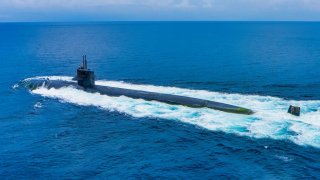'Unclosed Hatches' Sunk a U.S. Navy Nuclear Submarine at Port
In 1969, the USS Guitarro (SSN-665), a Sturgeon-class nuclear-powered attack submarine, sank while docked at the San Francisco Bay Naval Shipyard. Nearing completion after almost four years of construction, the submarine was undergoing final preparations when miscommunication between two work teams led to uncontrolled flooding.
What You Need to Know: In 1969, the USS Guitarro (SSN-665), a Sturgeon-class nuclear-powered attack submarine, sank while docked at the San Francisco Bay Naval Shipyard. Nearing completion after almost four years of construction, the submarine was undergoing final preparations when miscommunication between two work teams led to uncontrolled flooding.

-Both teams were filling tanks to adjust the vessel's position without coordinating their actions, causing water to reach uncovered hatches.
-The submarine gradually took on more water and ultimately submerged at the pier. It took three days to refloat the Guitarro, resulting in a nearly three-year commissioning delay and repair costs up to $140 million. The incident underscores the critical importance of coordination and communication in complex naval construction projects.
USS Guitarro: The U.S. Submarine That Sank While Docked
In September, U.S. defense officials revealed that the lead ship of a new class of Chinese nuclear-powered attack submarines sunk while undergoing construction.
The incident took place in the spring, and the Chinese government sought to hide the fact until a think tank analyst spotted the sunk sub at its pier.
Although a hugely embarrassing incident for the ambitious Chinese military, it is not unheard of for submarines to sink while at port. Indeed, the U.S. Navy experienced a similar incident, but fifty-five years ago when shipbuilding technology wasn’t as developed as it is today.
The Sinking of the USS Guitarro
It’s 1969. The war in Vietnam is raging. The Navy has committed important resources to supporting the ground fighting in southeast Asia. But the number one threat remains the Soviet Union. The Navy continues to invest in and prepare capabilities that would help it defeat the Soviet Navy in the event of a conflict.
Nuclear-powered submarines were all the rage. Using the immense energy of newly-tamed nuclear energy, subs powered by a nuclear reactor could operate for longer periods, sail faster, and were also harder to detect. Fast-attack submarines were particularly desired because of their ability to find and sink enemy warships and logistical vessels. To this day, a wolfpack of good fast-attack submarines properly led can wreak havoc on an adversary naval force.
May 15, 1969: A Submarine Goes Down
The USS Guitarro (SSN 665), a Sturgeon class nuclear-powered fast-attack submarine, is undergoing final touches before it gets commissioned and joins the operational fleet. Construction of the warship is taking place at the San Francisco Bay Naval Shipyard. Work on the sub is proceeding as scheduled. Indeed, has been under construction for four almost four years, and the plan is to commission it in eight months.
Then, all of a sudden, at approximately 8:30 PM, the USS Guitarro starts sinking while still tied to the dock. Nuclear and non-nuclear construction groups had been working on the boat on two different assignments that required filling certain tanks on the boat to bring it closer to the surface. The two groups had not been coordinating despite working on assignments that influenced one another, and the water reached uncovered hatches. The submarine kept taking more and more water. Eventually, the submarine could take no more and sunk.
The Navy conducted a thorough investigation following the incident to determine what caused one of its priced nuclear-powered attack submarines to sink while in port. The cause of the sinking was “uncontrolled flooding within the forward part of the ship.” The report concluded that the sinking was accidental. However, the immediate cause of the sinking was, “culpable negligence of certain shipyard employees.” Moreover, inadequate coordination contributed to the accident.
It took Navy crews three days to refloat the sunk submarine.
The whole incident caused a commissioning delay of almost three years and up to $140 million in repair costs.
Building and maintaining a naval fleet is not an easy task. And enemy fire is not the only danger to the longevity of a fleet.
About the Author:
Stavros Atlamazoglou is a seasoned defense journalist specializing in special operations and a Hellenic Army veteran (national service with the 575th Marine Battalion and Army HQ). He holds a BA from the Johns Hopkins University and an MA from the Johns Hopkins’ School of Advanced International Studies (SAIS). His work has been featured in Business Insider, Sandboxx, and SOFREP.
Image Credit: Creative Commons and/or Shutterstock.


